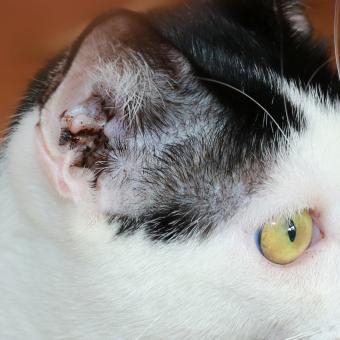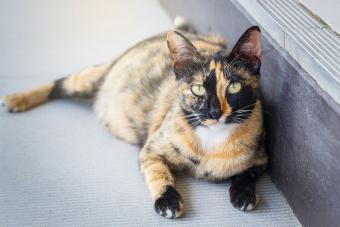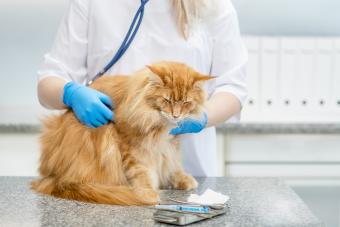
Cat skin problems are a common concern for many pet owners. These conditions can lead to rashes, fur loss, and general poor health. Viewing pictures of cat skin conditions can help you better understand what might be your cat's issue, so you can get them the help they need.
Fleas and Flea Allergy

One of the most common causes of feline skin problems is a flea infestation. Even if your cat is inside most or all of the time, fleas can jump and still make their way indoors. Fleas can be treated or prevented through the use of a variety of products that are applied on the skin at the back of the neck.
Some of these products are prescriptions, whereas some can be purchased over-the-counter. If you aren't familiar with these, you can speak to your veterinarian about the best choice for your pet. Flea treatment may also require a quick-acting pill such as Capstar, bathing with normal or medicated shampoo, or treating your home.
Cat Allergies

Cats can have just as many types of allergies as humans. Common allergens include specific proteins in food, pollen, grasses, molds, and more. Allergies can result in hair loss, secondary skin infections caused by scratching, and even weight loss.
Food allergy testing will usually involve feeding your cat a very strict diet, and your vet can use blood or skin tests to check for environmental allergies. Treating allergies can sometimes be difficult and may require prescription diets, home-cooked diets, allergy injections, or oral medications.
Mites on Cats

Some types of mites that affect cats include ear mites, Demodex cati, Demodex gatoi, the cat fur mite, and Notoedres cati. Many cats with mites will be very itchy, and hair loss, crusting, or skin infections can also be apparent. Cats with mites may need medicated baths or dips, injectable or topical medications, or over-the-counter parasite treatments. The best way to treat mites in cats will depend on the specific mite involved. See your vet for an exact diagnosis.
Fungus (Ringworm)

The most common fungus cats pick up is ringworm. This fungus produces circular patches of hair loss and crusting as it attacks hair shafts and spreads outward. Some cats do not show any skin symptoms of ringworm but can still transmit it to other cats.
Ringworm should be treated quickly and all areas where the cat frequents (litter box and bedding) should be thoroughly cleaned with bleach. Ringworm can be contagious to humans, so head to your vet immediately if you suspect your cat has this fungus and take precautions to protect yourself. Treatment can vary from oral medications to medicated dips.
Feline Acne

Feline acne shows up as blackheads, pimples, and sores on the chin and lower face of your cat. The condition can be quite irritating. Cats with acne tend to rub their faces on the floor or rub at their chins with their feet, and can sometimes improve if their bowls are switched from plastic to stainless steel or ceramic bowls, as these are better. This skin condition sometimes requires antibiotics prescribed by your vet, though washing your cat's chin with soap and water can often help improve the acne.
Wounds and Abscesses

Wounds and scrapes can quickly turn into something more serious. Once the skin is broken, bacteria can colonize the area leading to secondary infection and abscesses. This often happens in cats that go outside and are bitten by other cats. An abscess often forms a few days after the initial injury has healed.
Your vet can evaluate the wound and prescribe antibiotics to eliminate the infection. Sometimes surgery is needed to drain the abscess properly, and if your cat is very weak or debilitated, other medicine could be required.
Feline Miliary Dermatitis

Miliary dermatitis is a pattern of skin disease caused by any number of allergens, including fleas. It looks like small, crusted bumps that appear on a cat's head, neck, back, and tail. Many affected cats over-groom themselves to try to relieve the itching, and in severe cases, the cat may even bite and pull out their fur. Treatment will require a trip to your vet and could consist of antibiotics or medicine for the itching.
Eosinophlic Ulcers (Rodent Ulcers)

Eosinophilic ulcers are also called indolent ulcers or rodent ulcers. They appear as sores on the lips of your cat, usually right in the front near the nose. These ulcers are usually caused by some type of allergy.
See your veterinarian to make sure that any sores on the lips are not something more serious. Treatment may require injectable or oral medications. In mild cases, sometimes the ulcers will heal without treatment.
Sign up for our newsletter featuring all the latest stories and products we love.
Shedding and Furballs

Cats with long fur may shed more than normal if not brushed regularly. This can lead to matted fur and discomfort. Many cats will groom and ingest excessive amounts of their own fur.
This extra fur can eventually result in vomiting, or in rare cases, can cause a bowel obstruction. The best source of prevention is regular brushing, although there are some foods and treats on the market created to reduce hairball formation.
Cat Skin Problems Are an Indication of Illness

Fur and skin problems can be an outward sign of illness. A cat's fur should ideally be sleek and smooth. A cat with greasy or ragged fur may have an underlying medical condition that needs to be addressed.
Additional Cat Health Issues

The skin problems covered in this slideshow are just a few of the diseases and symptoms from which cats might suffer. Some health problems also surface at a higher rate in certain breeds. If you suspect your cat may be ill, schedule a complete exam with your vet to get to the source of the problem.






